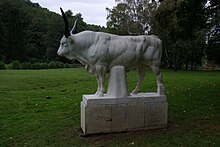Gesundbrunnenstrasse

The Gesundbrunnen street is a street in Bad Freienwalde (Oder) . Fifteen houses in the street are listed. A detailed list of the listed houses can be found in the list of architectural monuments in Bad Freienwalde (Oder) .
Location and history
As early as 1767/1768 there was a promenade on the section between Fontaneplatz and Gesundbrunnen. The street was first paved in 1848, after which houses were built along the street.
The street begins on Königsstraße , from which it branches off towards the south at an acute angle. After about 70 meters, Berliner Straße crosses Gesundbrunnenstraße as Bundesstraße 158 on a flat bridge. From Fontaneplatz, the street curves in a westward curve and then ends in a dead end at the spa gardens. Other streets that cross Gesundbrunnenstrasse or leave it are Melcher Strasse, Maltzanstrasse, Sonnenburger Strasse, August-Hesse-Strasse and Heilige Hallen .
The entire length of the street is about 1500 meters. The numbering of the houses starts on the Königstrasse on the left side and runs to the Kurpark and then back to Königstrasse. Sometimes the Brunnenpromenade runs parallel to the Gesundbrunnenstraße and is slightly elevated.
The Kurhaus theater and the park with the Gesundbrunnen are located on Gesundbrunnenstrasse.
The houses
15 houses are listed on Gesundbrunnenstrasse. The most interesting houses are:
- Gesundbrunnenstrasse 1: The house is on the corner of Königstrasse and Gesundbrunnenstrasse. It was built as the “Zum Kurfürst” hotel. The city administration has been located in the building since 1945. Today, among other things, the police are sitting here.
- Gesundbrunnenstraße 10: The house was built around 1880/1890. It is a two-story building with a gable roof. The facade was built in the style of late historicism .
- Gesundbrunnenstraße 13: The so-called "Karl-Weise-Haus" was probably built around 1867. The local poet Karl Weise lived here. On one of the pillar of the fence there is a bronze plate to commemorate the 100th anniversary of Karl Weise's death.
- Gesundbrunnenstraße 17: The summer house was built from 1873 to 1874. It is a gable-independent house with a gable roof . From the first floor the half-timbered structure is visible in a kind of alpine style.
- Gesundbrunnenstraße 20: The house is located directly on Fontaneplatz. The Villa Antonia was built in 1875. The house has a three-axis central projection in the classicism style .
- Gesundbrunnenstraße 21: The house is opposite Fontaneplatz at the beginning of Sonnenburger Straße. The house was built in 1871/1872, but later rebuilt. From 1950 to 1955 there was a polyclinic here, then the Brunnen pharmacy until 1995. The house is two-story with a gable roof . The front to the street is designed with a central projection.
- Gesundbrunnenstraße 23: The house was probably built as a guesthouse at the end of the 19th century . The house is right on the street. The first floor is dominated by a loggia in Ädikulaform .
- Gesundbrunnenstraße 24: The villa is slightly higher than the Finkenberg. The house was built after the land was acquired in 1873. The house has six axes, the middle two form a risalit.
- Gesundbrunnenstraße 29: The Villa Johanna was built around 1867. From 1890 the villa was the summer residence of the artist Fritz Kühnemann. The house is on one floor facing the street. The facade is characterized by a semicircular portico with columns.
- Gesundbrunnenstraße 32a: There was a water mill here as early as 1490. After a fire, the mill building was rebuilt in 1859. In the years that followed, the building was rebuilt and extensions were added. In 1904 the eastern part was leased out as a nursery, and in 1908 the Papenmühle restaurant was built. During the Second World War the house was a military hospital, after the war it was used as a residential building.
- Gesundbrunnenstraße 33 / 33a: Today the Gesundbrunnen is a specialist clinic. The complex includes the spa gardens and the lodging house . In the spa gardens there is, among other things, the sculpture Bull by Louis Tuaillon , which, however, has remained incomplete.
literature
- Ilona Rohowski, Ingetraud Senst: Monument topography Federal Republic of Germany, monuments in Brandenburg. Volume 9.1: District of Märkisch-Oderland. Part 1: towns of Bad Freienwalde and Wriezen, villages in Niederoderbruch. Wernersche Verlagsgesellschaft, Worms am Rhein 2006, ISBN 3-88462-230-7 , pp. 96–112.
Individual evidence
- ↑ List of monuments of the state of Brandenburg: Landkreis Märkisch-Oderland (PDF) Brandenburg State Office for Monument Preservation and State Archaeological Museum
Coordinates: 52 ° 46 ′ 47.6 " N , 14 ° 1 ′ 49.2" E


